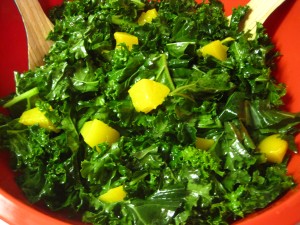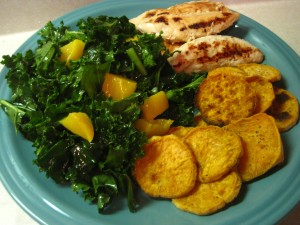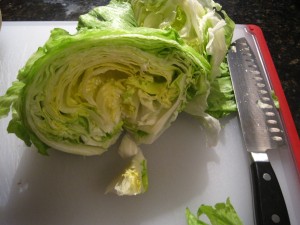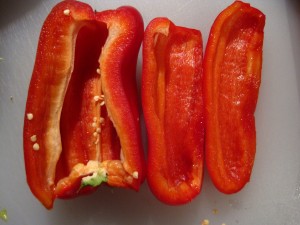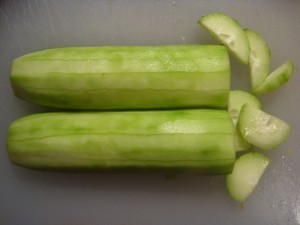Nothing sounds better on a freezing cold night than a big bowl of chili. It’s warm, hearty, delicious comfort food – but it can be healthy comfort food! The best thing about chili is that you can pretty much add whatever ingredients you want as long as you have the basics: meat, beans, beer, and the right spices (that’s right: beer).
I may be biased, but I believe my mom makes the best chili. When I called her to ask her for the recipe (for about the 15th time), she replied, “Well, I just add a little of this and a little of that.” I asked, “Well do you know how much chili powder or cumin you add?” She answered, “I add enough to make it taste good.” So I improvised. That’s why I call it my mom’s crazy chili recipe – there really isn’t any set recipe. But those basics I mentioned are in there, and that’s the key. I also truly believe that beer is the secret ingredient to setting this one over the top.
I’m going to break down necessary ingredients and optional ingredients. I’ll also give you healthy and indulgent options. Lastly, you can make this either on the stove or in the crock pot, so I’ll give you both options there, too. However, there is one area where you don’t have an option: you cannot make just a little bit of chili. You have to make a giant pot. But that’s a good problem to have because chili makes the best leftovers!

This one was hard to tag because you can make it as healthy as you want! As long as you have the basics, it’s delicious.
What you’ll need:
Necessary ingredients:
- 2 tablespoons olive oil
- 1-1.25 pounds ground meat – use ground turkey for a healthier option, but I love the taste of ground beef.
- 1 large onion, chopped
- 4 teaspoons minced garlic – not necessary to have fresh garlic, but garlic in general is necessary. Use more garlic powder if you don’t use fresh garlic.
- 1 tablespoon garlic powder – garlic powder is necessary, even if you use fresh garlic. If you don’t use fresh garlic, too, then triple the garlic powder.
- 4 tablespoons cumin
- 4 tablespoons chili powder
- 3 bay leaves
- 28 ounce can crushed tomatoes
- 1 can or bottle of dark beer – ales, nut browns, stouts, or porters are the best. In a pinch, you can use a light beer, but stay away from IPAs.
- 2 cans red kidney beans, rinsed
Optional ingredients:
- Bell peppers, chopped – I like green because it adds color; I use 2 bell peppers
- Cayenne pepper – adjust the amount to make it more or less spicy; I use 1/2 teaspoon
- Celery, chopped – it adds a nice crunch to the chili, just use however much you have in the fridge
- Carrots, chopped – it adds a little sweetness to the chili, again, use however much you have in the fridge
- Bacon, crumbled – either turkey bacon or regular bacon is delicious, turkey bacon is healthier
- Rice – it’s traditional in my family to serve chili over rice
- Cheddar cheese – I love topping my chili with cheese!
What you’ll need to do:
Brown your meat in the two tablespoons olive oil over medium-high heat on the stove for about 5-7 minutes. If you’re going to use a crock pot, use a large pan. If you’re going to make the chili in a pot on the stove, just brown the meat in the pot. As the meat is browning, constantly break it apart with a wooden spoon. You want the meat to be smaller crumbles instead of large chunks.
Or, as an alternative, cook the bacon in the pan first. Cut or tear the bacon into smaller pieces and put them in the pan so that they cook faster and so you don’t have to crumble it later. If you’re cooking turkey bacon, cook the turkey bacon in the olive oil. If you’re cooking regular bacon, don’t put any oil in the pan. Then brown your meat in the same pan with the bacon drippings.
When the meat has browned, turn the heat down to medium and add the onion. If you’re using fresh garlic or bell peppers, add those at this time, too. Cook for about 3 minutes or until the onion has turned translucent. Add all your dry spices, except the bay leaves, and stir with the spoon until the spices thoroughly coat the meat and veggies.
If you’re cooking in a crock pot, transfer the meat and veggies into the crock pot. Add the can of crushed tomatoes, beer, and bay leaves, either in the crock pot or big pot on the stove. Stir to mix.
Cover and let cook for many hours. If you’re using the crock pot, set on low heat for at least 6 hours – you can let this cook all day if you’re making it on a work day. If you’re cooking on the stove, turn the heat to low and let simmer for at least 4 hours, stirring occasionally. The chili generally tastes better the longer you let it cook.
In the last hour of cooking, add your kidney beans. You can also add celery or carrots at this time if you’re using them. Stir and cover.
I love serving my chili over rice and topping it with cheddar cheese. In my family, we’ve also been known to put chili over tamales, but that may be a Southern California thing. Of course, chili is also delicious on hot dogs, fries, or other ballpark food. I’ve also heard of people putting chili over noodles. If you want to make it healthier, chili would also be good over quinoa. But you don’t have to pair it with anything at all – this chili is also delicious all by itself.
Enjoy!



















